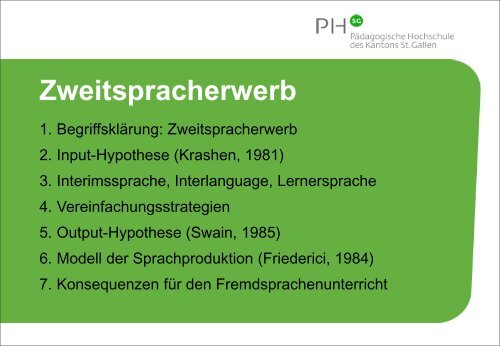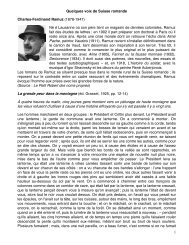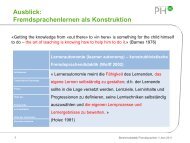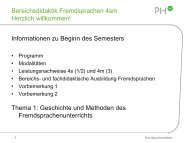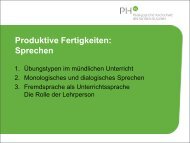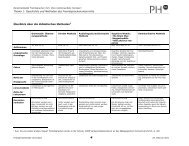Zweitspracherwerb - Optimisme.ch
Zweitspracherwerb - Optimisme.ch
Zweitspracherwerb - Optimisme.ch
Erfolgreiche ePaper selbst erstellen
Machen Sie aus Ihren PDF Publikationen ein blätterbares Flipbook mit unserer einzigartigen Google optimierten e-Paper Software.
<strong>Zweitspra<strong>ch</strong>erwerb</strong><br />
1. Begriffsklärung: <strong>Zweitspra<strong>ch</strong>erwerb</strong><br />
2. Input-Hypothese (Krashen, 1981)<br />
3. Interimsspra<strong>ch</strong>e, Interlanguage, Lernerspra<strong>ch</strong>e<br />
4. Vereinfa<strong>ch</strong>ungsstrategien<br />
5. Output-Hypothese (Swain, 1985)<br />
6. Modell der Spra<strong>ch</strong>produktion (Friederici, 1984)<br />
7. Konsequenzen für den Fremdspra<strong>ch</strong>enunterri<strong>ch</strong>t<br />
Fremdspra<strong>ch</strong>endidaktik 1
<strong>Zweitspra<strong>ch</strong>erwerb</strong><br />
L2-Erwerb<br />
gesteuert<br />
natürli<strong>ch</strong><br />
na<strong>ch</strong> L1<br />
glei<strong>ch</strong>zeitig wie L1<br />
<strong>Zweitspra<strong>ch</strong>erwerb</strong><br />
bilinguale<br />
Spra<strong>ch</strong>entwicklung<br />
Ergebnis:<br />
bilinguale/multilinguale Person<br />
Fremdspra<strong>ch</strong>endidaktik 2
Mehrspra<strong>ch</strong>igkeit<br />
Mehrspra<strong>ch</strong>iges Leben findet statt in<br />
vielfältigen vielspra<strong>ch</strong>igen<br />
Gebrau<strong>ch</strong>skontexten, wo das mehrspra<strong>ch</strong>ige<br />
Individuum sein Repertoire dynamis<strong>ch</strong><br />
anpasst, entwickelt und eben au<strong>ch</strong> dur<strong>ch</strong><br />
Ni<strong>ch</strong>tgebrau<strong>ch</strong> verliert.<br />
(Berthele, 2008)<br />
Fremdspra<strong>ch</strong>endidaktik 3
Fremdspra<strong>ch</strong>endidaktik 4
Input-Hypothese<br />
«We acquire language<br />
by understanding messages.»<br />
(Krashen,1981)<br />
Fremdspra<strong>ch</strong>endidaktik 5
Brenda (1;8) im Gesprä<strong>ch</strong> mit der Mutter:<br />
B: /fæ/<br />
M: hm?<br />
B: /fæ/<br />
M: fan! yeah.<br />
B: /k h u/<br />
M: cool, yeah. fan<br />
makes cool.<br />
Einwort-Äusserung<br />
Festlegung des Themas,<br />
worüber man spre<strong>ch</strong>en will: fan.<br />
M: Hilfestellung: fan! yeah.<br />
Neue Mitteilung: cool!<br />
Zusammenfassende Äusserung.<br />
Brenda liest aus einem Bilderbu<strong>ch</strong> vor:<br />
B: cook. say.<br />
Zweiwort-Äusserung<br />
M: what'd the cook say?<br />
B: something.<br />
Brenda (2;00) zeigt im Bilderbu<strong>ch</strong> auf ein Bild mit<br />
einem Knaben, der s<strong>ch</strong>reiben lernt, und sagt:<br />
Dreiwort-Äusserung<br />
B: write. write. read dat.<br />
(read the part about writing)<br />
Fremdspra<strong>ch</strong>endidaktik 6
Am Bahns<strong>ch</strong>alter<br />
Fremdspra<strong>ch</strong>endidaktik 7
11 I c’est des animaux? C’est des plantes? Qu’est-ce que c’est?<br />
12 E c’est euhm quelque <strong>ch</strong>ose euhm dans la le lac<br />
13 I oui .. ah des algues?<br />
14 E non non<br />
15 I non non<br />
16 E pas des algues euhm dans euh dans ces objets il y a des perles .<br />
17 I ah bon!<br />
18 E mais mais dans le lac ils sont petits<br />
19 I AH des coquillages ah oui des coquillages oui oui je vois où il y a les perles<br />
20 et tu as trouvé des perles? ((rit))<br />
21 E non non non mais ((rit)) non . mais il y a des aso die Mus<strong>ch</strong>le dans le lac<br />
22 I coquillages coquillages<br />
23 E coquillages oui<br />
24 I oui voilà<br />
25 E il y a dans le lac mais euhm il n’y a pas des perles<br />
26 I non parce que autrement ils les auraient déjà pris<br />
27 E c’est seulement dans la mer il y a des perles<br />
Fremdspra<strong>ch</strong>endidaktik 8
Interimsspra<strong>ch</strong>e<br />
Stufenweise Annäherung<br />
der Lernerspra<strong>ch</strong>e an<br />
die Zielspra<strong>ch</strong>e:<br />
Metapher der Treppe:<br />
IL 4<br />
IL 3<br />
IL 2<br />
IL 1<br />
Systematis<strong>ch</strong>e Fehler gehören zum Lernen und<br />
sind Teil der Lernerspra<strong>ch</strong>e.<br />
Fremdspra<strong>ch</strong>endidaktik 9
Verneinung<br />
Beispiel: Erwerbsstufen, Interlanguages in der L1<br />
Beispiel Erwerb der Negation (2. - 3. Lebensjahr)<br />
(Klima & Bellugi 1966; in Scollon, p. 24f.)<br />
Stage 1<br />
(use of NO at the start of the sentence)<br />
No the sun shining<br />
No Mary do it<br />
Stage 2<br />
(use of NO inside the sentence but no auxiliary or BE verb)<br />
There no rabbits<br />
I no taste it<br />
Stage 3<br />
(use of not with appropriate abbrevation of auxiliary or BE)<br />
Penny didn't laugh<br />
It's not raining<br />
Isoliertes no am Anfang des Satzes.<br />
Das no rückt an die ri<strong>ch</strong>tige Stelle.<br />
Es ers<strong>ch</strong>eint die ri<strong>ch</strong>tige Form.<br />
Fremdspra<strong>ch</strong>endidaktik 10
Vereinfa<strong>ch</strong>ungsstrategien<br />
1. Auslassung<br />
„abs<strong>ch</strong>niide S<strong>ch</strong>eer Papiir <strong>ch</strong>liine orans<strong>ch</strong>e“<br />
2. Reduktion der Formenvielfalt<br />
CH-deuts<strong>ch</strong>e de Baum de Baum<br />
Artikel: d Vase de Vase<br />
s Huus de Huus<br />
3. Regularisierung (Übergeneralisierung)<br />
Partizip Perfekt: singen gesingt<br />
Plural: Hund Hünder<br />
Fremdspra<strong>ch</strong>endidaktik 11
3 C: oui. ça te rappelle quelque <strong>ch</strong>ose ... des vacances?<br />
4 JF: eeh oui, oui<br />
5 JF: où?<br />
6 JF: eem Pontresina<br />
7 C: ah oui c’est vrai ça rappelle un peut. ... quand est-ce que tu va à<br />
Pontresina?<br />
8 JF: eem ... ah ... eem ... au glacier<br />
9 C: ah<br />
10 JF: oui ... ah oui<br />
11 C: tu vas en hiver ou en été?<br />
12 JF: en hiver et en été. en été nous al- nous faisons des des randonnées<br />
13 C: oui<br />
14 JF: et en en hiver nous faisons eh des aso faire du ski<br />
15 C: oui<br />
16 JF: nous faisons ski . ski<br />
<strong>ch</strong>unk<br />
17 C: tu fais du ski de fonds ou de piste?<br />
18 JF: eeh non je fais em je fais du snowboard<br />
Fremdspra<strong>ch</strong>endidaktik 12
Output-Hypothese<br />
„Learners need the opportunity for meaningful use of their<br />
linguistic resources to a<strong>ch</strong>ieve full grammatical competence.“<br />
„When learners experience communicative failure, they are<br />
pushed to make their output more precise, coherent and<br />
appropriate.“<br />
„Whereas comprehension of a message can take place with<br />
little syntactic analysis of the input, production forces learners<br />
to pay attention to the means of expression.“<br />
(Swain, 1985)<br />
Fremdspra<strong>ch</strong>endidaktik 13
Spra<strong>ch</strong>produktion<br />
Rezeption<br />
1<br />
2<br />
3<br />
4<br />
intentionale/<br />
motivationale Ebene<br />
begriffli<strong>ch</strong>e Ebene<br />
spra<strong>ch</strong>li<strong>ch</strong>e Ebene<br />
(Lexikon, Morpheme,<br />
Syntax)<br />
Lautebene<br />
z<br />
u<br />
n<br />
e<br />
h<br />
m<br />
e<br />
n<br />
d<br />
e<br />
V<br />
e<br />
r<br />
a<br />
r<br />
b<br />
e<br />
i<br />
t<br />
u<br />
n<br />
g<br />
s<br />
t<br />
i<br />
e<br />
f<br />
e<br />
Mitteilungsabsi<strong>ch</strong>t<br />
semantis<strong>ch</strong>e<br />
Repräsentation<br />
Aktivieren<br />
Auswählen<br />
Repräsentation der<br />
Wortformen und<br />
der grammat. Bezüge<br />
Satzbaupläne<br />
Repräsentation<br />
der Laute und<br />
S<strong>ch</strong>riftzei<strong>ch</strong>en<br />
Aktivieren von<br />
Satz/Wortformen<br />
Aktivieren des<br />
Artikulationssystems<br />
Äusserung<br />
(Friederici,1984)<br />
Fremdspra<strong>ch</strong>endidaktik 14
Begriffe / Konzepte<br />
Spra<strong>ch</strong>anfänger<br />
ältere Lernende<br />
Begriffe<br />
(Konzepte)<br />
gute Beherrs<strong>ch</strong>ung einer L2<br />
sehr junge Lernende<br />
Begriffe<br />
(Konzepte)<br />
L1<br />
Modell<br />
L2<br />
modèle<br />
L1<br />
Stuhl<br />
L2<br />
<strong>ch</strong>air<br />
Fremdspra<strong>ch</strong>endidaktik 15
Fazit<br />
1. Jeder Lerner baut si<strong>ch</strong> sein eigenes Spra<strong>ch</strong>system,<br />
seine eigene Lernerspra<strong>ch</strong>e auf.<br />
2. Die Lernenden nähern si<strong>ch</strong> stufenweise an die<br />
Zielspra<strong>ch</strong>e an (Metapher der Treppe).<br />
3. Systematis<strong>ch</strong>e Fehler gehören zum Lernen und<br />
sind Teil der Lernerspra<strong>ch</strong>e.<br />
4. Ents<strong>ch</strong>eidend bei der Spra<strong>ch</strong>verarbeitung ist die<br />
Verarbeitungstiefe: d.h. die Aktivierung der<br />
intentionalen und begriffli<strong>ch</strong>en Ebene beim Lernen.<br />
Konsequenzen für den Fremdspra<strong>ch</strong>enunterri<strong>ch</strong>t?<br />
Fremdspra<strong>ch</strong>endidaktik 16


